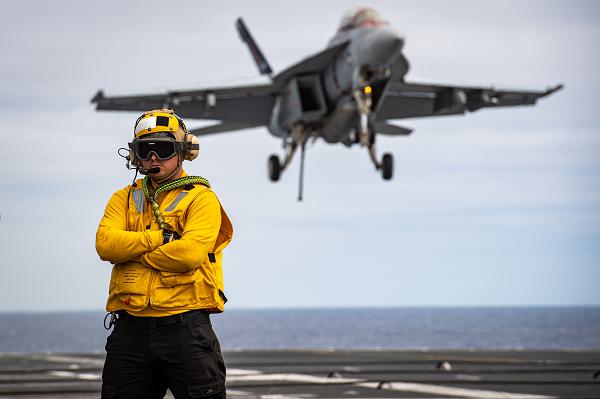
Pacific Ocean. (July 25, 2024): In this photo by MC2 Hannah Kantner, a Sailor appears casually indifferent to the F/A-18F Super Hornet streaking to a landing behind him on the aircraft carrier USS Nimitz. He is justly confident that the ship’s “arrested” landing system will capture the incoming aircraft for a safe, yet jarring, end of the flight.
Crewed by five thousand Sailors and Marines, these “cities at sea” use a launching and recovery system that has evolved dramatically since World War II. America’s first aircraft carrier was the USS Langley, a plodding flattop commissioned in 1922. This ship moved aircraft around using two onboard cranes to hoist seaplanes onto its deck for launch. These planes were launched using a compressed-air catapult installed on the bow.
This launch method is where the concept of “arrested” landings originated. The Navy decided to use a series of five arresting wires strung across the aft part of the flight deck to capture the airplanes’ trailing hook. Once the aircraft captures a wire, the planes’ momentum is abruptly stopped using weights in a block-and-tackle mechanism. Carriers later developed steam driven systems with pistons to generate the force to launch modern airplanes.
Today’s launching and recovering systems are futuristic by comparison.
The Navy has installed two new flight deck systems, the Advanced Arresting Gear (AAG) and the Electromagnetic Aircraft Launching System, or EMALS on the USS Gerald R. Ford, America’s most advanced carrier. Developed by General Atomics Electromagnetic Systems, these systems use a surge of electromagnetic energy to power the catapult and landing systems.
The main advantage of this innovative technology is smoother acceleration for launch which puts less stress on aircraft air frames. The system can launch heavier planes than steam catapults and its arresting wires can take on aircraft weighing up to fifty thousand pounds.
Always thrilling, carrier landings will continue to be routine for Airmen using these innovative technologies.


